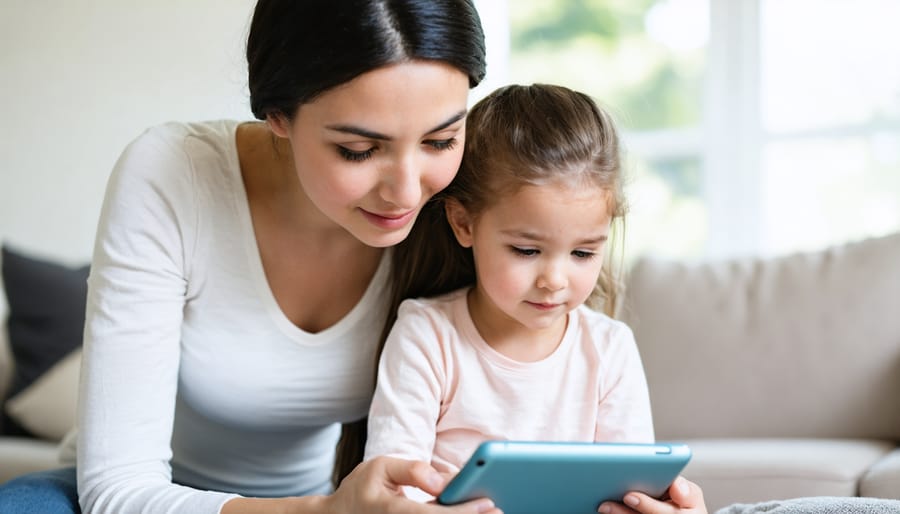In today’s hyper-connected world, children spend an average of seven hours daily interacting with digital media, fundamentally reshaping how they learn, play, and develop. Digital Wellness Labs, pioneered by leading child development experts and researchers, offer evidence-based solutions to help families navigate this complex digital landscape. These innovative facilities combine cutting-edge research with practical applications, creating a safe space where children learn healthy digital habits while parents gain valuable insights into managing screen time effectively.
Working at the intersection of technology, psychology, and education, Digital Wellness Labs empower families with personalized strategies that transform screen time from a source of conflict into an opportunity for growth and connection. Rather than taking an all-or-nothing approach to digital media, these labs help families develop balanced, sustainable relationships with technology that support children’s cognitive, social, and emotional development.
Through state-of-the-art research facilities and expert guidance, Digital Wellness Labs are revolutionizing our understanding of how digital experiences impact young minds, while providing parents with practical tools to make informed decisions about their children’s digital lives. This science-based approach ensures that families can embrace the benefits of technology while minimizing its potential risks.
What is a Digital Wellness Lab?
Core Components of Digital Wellness Labs
Digital Wellness Labs combine state-of-the-art technology with expert research methods to understand how digital media affects children’s wellbeing. At the heart of these facilities are specialized screening rooms where researchers observe how young people interact with various digital platforms and devices in a natural setting.
The labs feature eye-tracking technology and behavioral monitoring systems that help researchers understand what catches children’s attention online and how they respond to different types of content. Advanced data analytics tools process this information, providing insights into digital usage patterns and their impact on mental health, social development, and learning.
Teams of child psychologists, media researchers, and technology experts work together using both qualitative and quantitative research methods. They conduct interviews with families, analyze screen time data, and perform long-term studies on digital media effects. Many labs also maintain partnerships with schools and healthcare providers, creating a comprehensive network for studying real-world digital wellness challenges.
Family-friendly testing areas allow parents to participate in research activities, while specialized equipment measures stress responses and engagement levels during digital media use. These findings help develop practical guidelines for healthy technology use at home and in educational settings.
The Expert Team Behind Digital Wellness Labs
The Digital Wellness Labs brings together a diverse team of dedicated professionals who share a common goal: supporting healthy digital engagement for children and families. Led by Dr. Michael Rich, a pediatrician and former filmmaker, the team combines clinical expertise with real-world understanding of media’s impact on young minds.
Our research team includes child psychologists, developmental experts, and data scientists who study how digital media affects child development, mental health, and family dynamics. Working alongside them are education specialists who translate research findings into practical guidance for schools and families.
The labs also feature media designers and technology experts who understand both the creative and technical aspects of digital platforms. This unique combination allows us to evaluate digital content through multiple lenses – considering both its entertainment value and developmental impact.
Communication specialists and parent educators on our team ensure that our findings and recommendations reach families in clear, actionable ways. They create resources, host workshops, and provide direct support to parents navigating digital challenges.
Together, this multidisciplinary team works collaboratively to promote positive digital experiences while addressing concerns about screen time, online safety, and digital well-being.

How Digital Wellness Labs Support Your Child’s Health

Screen Time Management
Recent research from our digital wellness initiatives has shown that establishing healthy screen time habits requires a balanced, personalized approach rather than rigid rules. Dr. Sarah Chen, our lead researcher, emphasizes that quality of content matters more than strict time limits.
For younger children (ages 2-5), we recommend interactive screen activities limited to 1-2 hours daily, always with parental participation. Older children and teens benefit from scheduled “tech breaks” throughout the day, helping them develop self-regulation skills.
Some effective strategies we’ve developed include:
– Creating device-free zones, especially during meals and bedtime
– Using screen time tracking apps to build awareness
– Establishing regular outdoor activities as alternatives
– Planning “digital sunset” times an hour before bed
Parents report particular success with our “3M” approach: Model (demonstrate healthy habits yourself), Monitor (stay aware of usage patterns), and Modify (adjust strategies based on your child’s needs). Remember, every family’s journey is unique, and it’s okay to adjust these recommendations to fit your situation.
Digital Safety and Privacy
In today’s digital landscape, protecting children online requires a comprehensive approach combining technical safeguards with open communication. The Digital Wellness Lab recommends implementing parental controls and content filters while teaching children about responsible internet use. Start by setting up secure passwords and enabling two-factor authentication on all devices.
Create family agreements about screen time, appropriate content, and online behavior. Teach children about privacy settings and the importance of never sharing personal information online. Help them understand that digital footprints are permanent and can impact their future.
Monitor online activities without being intrusive by using family-friendly apps and browser extensions. These tools can block inappropriate content while allowing age-appropriate exploration. Equally important is teaching children how to recognize and report cyberbullying, suspicious behavior, or uncomfortable situations.
Remember to model good digital habits yourself. When children see parents practicing healthy digital boundaries and safety measures, they’re more likely to adopt these behaviors naturally. Stay involved in their digital lives through regular conversations about their online experiences.
Mental Health Monitoring
Digital wellness labs employ innovative tools and approaches to monitor children’s emotional well-being as they navigate digital spaces. Through careful observation and data collection, researchers track various indicators including screen time patterns, social media engagement, and online behavior to understand how digital experiences affect young minds. These insights help create personalized strategies for maintaining positive digital wellness and mental health.
Expert child psychologists work alongside technology specialists to develop age-appropriate assessment tools that help identify early warning signs of digital stress or anxiety. Parents receive regular feedback and practical guidance, while children learn to recognize and express their feelings about their online experiences. The lab environment provides a safe space where young people can openly discuss their digital challenges and receive professional support.
Through collaborative efforts with schools and families, these labs create comprehensive support systems that protect and nurture children’s emotional well-being in our increasingly connected world.
Practical Tips from Digital Wellness Labs

Creating Healthy Digital Boundaries
Creating healthy boundaries around technology use is essential for both children and adults in today’s digital world. When it comes to setting digital boundaries, consistency and clear communication are key. Start by establishing device-free zones in your home, such as the dining room or bedrooms, and set specific time limits for screen use.
Consider implementing a “tech sunset” rule where devices are turned off an hour before bedtime to promote better sleep habits. Create a family media agreement that outlines when, where, and how long technology can be used. This agreement should be age-appropriate and reviewed regularly as your children grow and their needs change.
Remember to model healthy digital habits yourself – children often learn best by example. Take regular breaks from screens, engage in offline activities together, and make time for face-to-face conversations. When setting limits, explain the reasoning behind them to help children understand why these boundaries matter for their well-being.
Be flexible but firm with your guidelines, and celebrate when family members successfully maintain their digital boundaries. This positive reinforcement helps create lasting healthy habits and a balanced relationship with technology.
Fostering Positive Digital Experiences
Creating positive digital experiences starts with active engagement in your child’s online activities. Rather than focusing solely on screen time limits, consider the quality of digital interactions. Encourage educational apps, creative digital projects, and meaningful online connections with friends and family.
Dr. Sarah Chen, a digital wellness expert, suggests: “Think of technology as a tool for growth rather than something to fear. When guided properly, children can develop valuable skills through digital experiences.”
Here are practical ways to foster healthy tech use:
– Co-view content with your children and discuss what they’re seeing
– Create designated tech-free zones and times for family connection
– Choose age-appropriate apps that encourage learning and creativity
– Model healthy digital habits yourself
– Celebrate positive online achievements and creative digital projects
– Use parental controls as teaching tools rather than restrictions
Remember to maintain open dialogue about online experiences. Ask your children about their favorite digital activities and show genuine interest in their virtual world. This approach helps build trust and encourages them to share concerns or challenges they encounter online.
By focusing on the positive aspects of technology while providing appropriate guidance, we can help children develop healthy digital habits that will serve them well into the future.
As we’ve explored throughout this article, digital wellness labs play a crucial role in helping our children thrive in today’s connected world. These research-based resources provide invaluable guidance for families navigating the challenges and opportunities of digital media. The key is not to fear technology but to embrace it mindfully and intentionally.
Remember that you’re not alone in this journey. Digital wellness labs offer evidence-based strategies, practical tools, and supportive communities to help your family create healthy digital habits. Whether you’re concerned about screen time, social media use, or online safety, these resources can help you make informed decisions that work for your unique family situation.
We encourage you to take the next step by exploring the resources mentioned above, connecting with digital wellness experts, and starting conversations with your children about their digital experiences. Small changes in how we approach technology can make a significant difference in our children’s well-being and development.
By staying informed and engaged with digital wellness resources, you’re helping create a healthier digital future for the next generation. Together, we can help our children build positive relationships with technology while protecting their mental health and social development.

